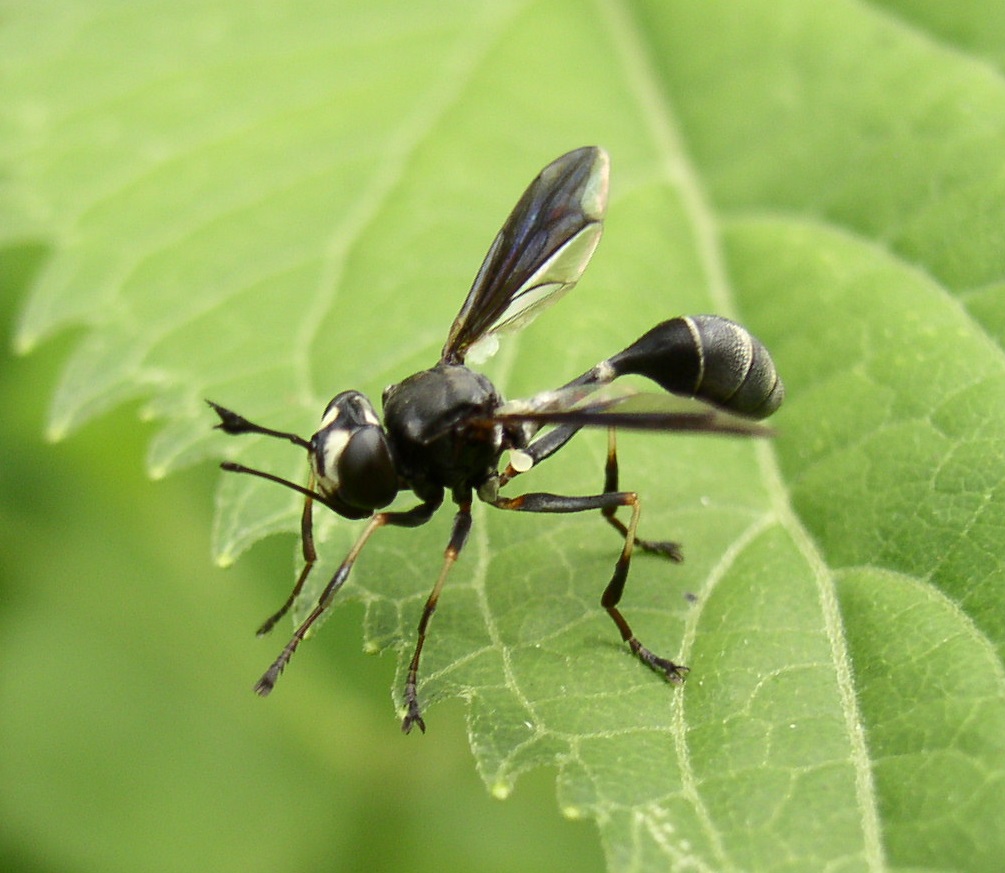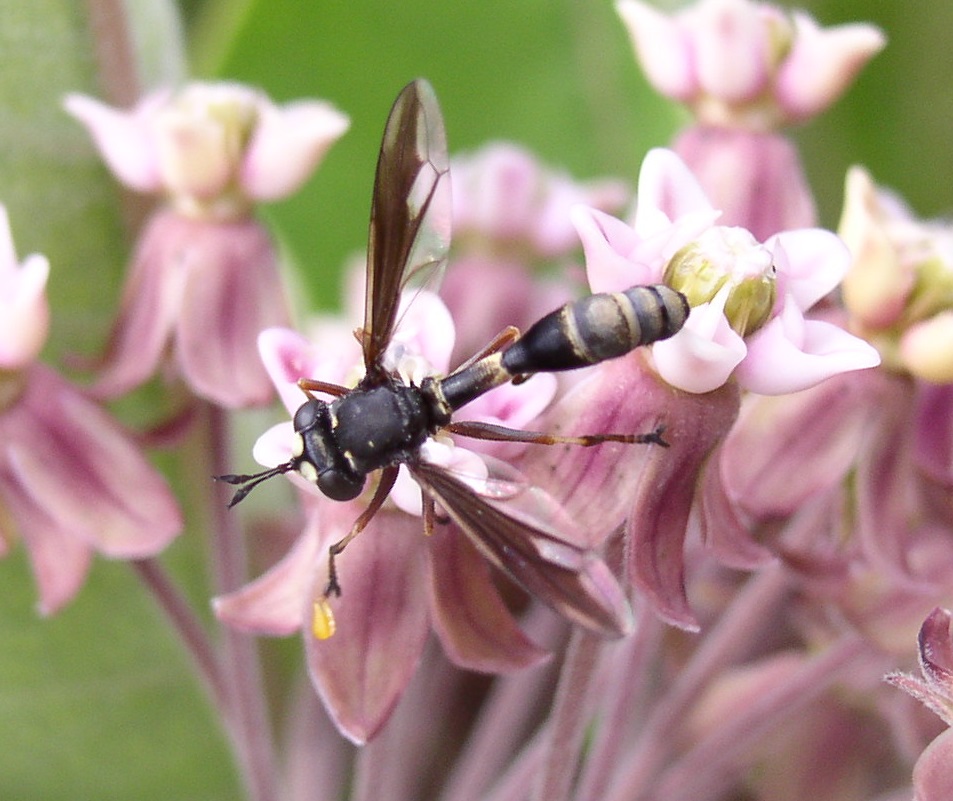|
Conopidae
The Conopidae, usually known as the thick-headed flies, are a family of flies within the Brachycera suborder of Diptera, and the sole member of the superfamily Conopoidea. Flies of the family Conopidae are distributed worldwide in all the biogeographic realms except for the poles and many of the Pacific islands. About 800 species in 47 genera are described worldwide, about 70 of which are found in North America. The majority of conopids are black and yellow, or black and white, and often strikingly resemble wasps, bees, or flies of the family Syrphidae, themselves notable bee mimics. A conopid is most frequently found at flowers, feeding on nectar with its proboscis, which is often long. Description For terms see Morphology of Diptera. Rather thinly pilose or nearly bare, elongate or stout flies of small to large size (3–20 mm, usually 5–15 mm). They are often lustrous with a black and yellow colour pattern or with reddish brown markings. The head is broad and ... [...More Info...] [...Related Items...] OR: [Wikipedia] [Google] [Baidu] |
Conops Quadrifasciatus
''Conops quadrifasciatus'', the yellow-banded conops, is a species of fly from the genus ''Conops'' in the family Conopidae. Distribution and habitat This species is common throughout much of Europe. It is also present in Russia, Turkey and Iran. These conopds can be found mainly on rough flowery places, on meadows and on roadsides. Description ''Conops quadrifasciatus'' can reach a length of .These wasp-like conopids have a black head and body. The abdomen is basically black with a vivid yellow bands. Face is yellow, but above antennal implant is black, and the area containing the ocelli has the same colour as the eyes. The antennae are black. It has a long proboscis. Thorax and scutellum are black. The posterior margins of the first four segments of the abdomen are yellow, the fifth segment is yellow. Tergite 1-3 are mainly black. The legs are yellow-brown. Femurs 2 and 3 are uniformly pale, sometimes with a small darkened spot. In males tergite is 5 black with broad yell ... [...More Info...] [...Related Items...] OR: [Wikipedia] [Google] [Baidu] |
Physocephala Tibialis
''Physocephala tibialis'' is a species of thick-headed fly (family Conopidae) found throughout the eastern United States, often near flowering plants. The adult fly is primarily black with a yellow face and thin white stripes on the abdomen. It is commonly found along the east coast of the United States and is often found near flowering plants. ''P. tibialis'' flies parasitize many different species of bees by laying their eggs inside the abdomen of their host. The larva hatches inside of the host and grows and develops until it takes up the majority of the host's abdomen. The host then dies and the larva envelopes itself in a puparium and pupates inside of the corpse. After an extended period of pupation, the adult emerges from the corpse of the host bee. When a bee becomes parasitized by a ''P. tibialis'' larva, certain behaviors such as induced grave digging and changes in flower preference often occur. Geographic distribution ''P. tibialis'' is found in North America, primari ... [...More Info...] [...Related Items...] OR: [Wikipedia] [Google] [Baidu] |
Thecophora
''Thecophora'' is a genus of thick-headed fly from the family Conopidae. They are frequently found on flowers. They are endoparasites of other insects, specially bees. Species These 42 species belong to the genus ''Thecophora'': * '' Thecophora abbreviata'' (Loew, 1866) * '' Thecophora africana'' (Brunetti, 1925) * '' Thecophora apivora'' Zimina, 1968 * '' Thecophora atra'' ( Fabricius, 1775) * '' Thecophora australiana'' (Camras, 1955) * ''Thecophora bimaculata'' Preyssler, 1791 * '' Thecophora caenovala'' (Krober, 1916) * '' Thecophora caevovalva'' (Krober, 1915) * '' Thecophora cinerascens'' Meigen, 1804 * '' Thecophora clementsi'' * '' Thecophora curticornis'' (Krober, 1916) * '' Thecophora distincta'' ( Wiedemann in Meigen, 1824) * '' Thecophora flavicornis'' (Krober, 1936) * '' Thecophora flavipes'' (Brunetti, 1923) * '' Thecophora freidbergi'' * ''Thecophora fulvipes'' Robineau-Desvoidy, 1830 * ''Thecophora haitiensis'' (Parsons, 1940) * ''Thecophora hyalipennis'' ( ... [...More Info...] [...Related Items...] OR: [Wikipedia] [Google] [Baidu] |
Physocephala
''Physocephala'' is a genus of flies from the family Conopidae. Species *'' P. antiqua'' ( Wiedemann, 1830) *'' P. biguttata'' von Röder, 1883 *'' P. burgessi'' (Williston, 1882) *'' P. chrysorrhoea'' ( Meigen, 1824) *'' P. curticornis'' Kröber, 1915 *'' P. floridana'' Camras, 1957 *'' P. furcillata'' (Williston, 1882) *'' P. lacera'' ( Meigen, 1824) *'' P. laeta'' Becker, 1913 *'' P. laticincta'' (Brullé, 1832) *'' P. marginata'' (Say, 1823) *'' P. nervosa'' Krober, 1915 *'' P. nigra'' ( De Geer, 1776) *'' P. pusilla'' ( Meigen, 1824) *'' P. rufipes'' ( Fabricius, 1781) *'' P. sagittaria'' (Say, 1823) *'' P. texana'' (Williston, 1882) *'' P. tibialis'' (Say Say may refer to: Music *''Say'' (album), 2008 album by J-pop singer Misono * "Say" (John Mayer song), 2007 *"Say (All I Need)", 2007 song by American pop rock band OneRepublic * "Say" (Method Man song), 2006 single by rapper Method Man * "Say" ( ..., 1829) *'' P. truncata'' ( Loew, 1847) *'' P. vaginalis'' ( Rondani ... [...More Info...] [...Related Items...] OR: [Wikipedia] [Google] [Baidu] |
Myopa
''Myopa'' is a genus of flies from the family Conopidae. They are parasitic on honey bees ''Apis mellifera'', also ''Andrena'', and mustache bees ''Anthophora''. Species *'' M. bohartorum'' Camras, 1953 *'' M. buccata'' (Linnaeus, 1758) *'' M. castanea'' (Bigot, 1887) *'' M. clausa'' Loew, 1866 *'' M. curticornis'' Kröber, 1916 *'' M. curtirostris'' Kröber, 1916 *'' M. dorsalis'' Fabricius, 1794 *'' M. extricata'' Collin, 1960 *'' M. fasciata'' Meigen, 1804 *'' M. fenestrata'' Coquillett, 1902 *'' M. flavopilosa'' Kröber, 1916 *'' M. longipilis'' Banks, 1916 *'' M. melanderi'' Banks, 1916 *'' M. metallica'' Camra, 1992 *'' M. minor'' Strobl, 1906 *'' M. mixta'' Frey, 1958 *'' M. morio'' Meigen, 1804 *'' M. occulta'' Wiedemann in Meigen, 1824 *'' M. perplexa'' Camras, 1953 *'' M. picta'' Panzer, 1798 *'' M. plebeia'' Williston, 1885 *'' M. polystigma'' Rondani, 1857 *'' M. rubida'' (Bigot, 1887) *'' M. stigma'' Meigen, 1824 *'' M. strandi'' Duda, 1940 *'' M. tess ... [...More Info...] [...Related Items...] OR: [Wikipedia] [Google] [Baidu] |
Stylogaster
The conopidae, conopid genus ''Stylogaster'' is a group of unusual flies. It is the only genus in the subfamily Stylogastrinae, which some authorities have historically treated as a separate family Stylogastridae (or Stylogasteridae). Biology Stylogastrines are obligate associates of Cockroaches, Orthoptera, some Calyptratae, Diptera and ants.Couri, M.S., Pont, A.C. & Kirk-Spriggs, A.H. 2013. New Muscidae (Diptera) hosts of ''Stylogaster'' Macquart (Diptera: Conopidae) from the Afrotropical Region. ''African Invertebrates'' 54 (2): 401–40/ref> These flies typically use army ants' raiding columns to flush out their prey, ground-dwelling Orthoptera and/or Cockroach, roaches. Stylogastrines are somewhat atypical for conopids, in that the egg itself is shaped somewhat like a harpoon, with a rigid barbed tip, and the egg is forcibly jabbed into the host. The female of some species waits for army ants to flush out a target, then she dives in and jabs an egg into the host. The ''Sty ... [...More Info...] [...Related Items...] OR: [Wikipedia] [Google] [Baidu] |
Physocephala Tibialis Male
''Physocephala'' is a genus of fly, flies from the family (biology), family Conopidae. Species *''Physocephala antiqua, P. antiqua'' (Christian Rudolph Wilhelm Wiedemann, Wiedemann, 1830) *''Physocephala biguttata, P. biguttata'' von Röder, 1883 *''Physocephala burgessi, P. burgessi'' (Williston, 1882) *''Physocephala chrysorrhoea, P. chrysorrhoea'' (Johann Wilhelm Meigen, Meigen, 1824) *''Physocephala curticornis, P. curticornis'' Otto Kröber, Kröber, 1915 *''Physocephala floridana, P. floridana'' Camras, 1957 *''Physocephala furcillata, P. furcillata'' (Williston, 1882) *''Physocephala lacera, P. lacera'' (Johann Wilhelm Meigen, Meigen, 1824) *''Physocephala laeta, P. laeta'' Theodor Becker, Becker, 1913 *''Physocephala laticincta, P. laticincta'' (Brullé, 1832) *''Physocephala marginata, P. marginata'' (Thomas Say, Say, 1823) *''Physocephala nervosa, P. nervosa'' Krober, 1915 *''Physocephala nigra, P. nigra'' (Charles De Geer, De Geer, 1776) *''Physocephala pusilla, P. pu ... [...More Info...] [...Related Items...] OR: [Wikipedia] [Google] [Baidu] |
Stylogastrinae
The conopidae, conopid genus ''Stylogaster'' is a group of unusual flies. It is the only genus in the subfamily Stylogastrinae, which some authorities have historically treated as a separate family Stylogastridae (or Stylogasteridae). Biology Stylogastrines are obligate associates of Cockroaches, Orthoptera, some Calyptratae, Diptera and ants.Couri, M.S., Pont, A.C. & Kirk-Spriggs, A.H. 2013. New Muscidae (Diptera) hosts of ''Stylogaster'' Macquart (Diptera: Conopidae) from the Afrotropical Region. ''African Invertebrates'' 54 (2): 401–40/ref> These flies typically use army ants' raiding columns to flush out their prey, ground-dwelling Orthoptera and/or Cockroach, roaches. Stylogastrines are somewhat atypical for conopids, in that the egg itself is shaped somewhat like a harpoon, with a rigid barbed tip, and the egg is forcibly jabbed into the host. The female of some species waits for army ants to flush out a target, then she dives in and jabs an egg into the host. The ''Sty ... [...More Info...] [...Related Items...] OR: [Wikipedia] [Google] [Baidu] |
Myopinae
Myopinae is a subfamily of flies from the family Conopidae. Tribes *Myopini *Sicini Sicini is a tribe of flies from the family Conopidae. Genera *'' Sicus'' Scopoli Giovanni Antonio Scopoli (sometimes Latinized as Johannes Antonius Scopolius) (3 June 1723 – 8 May 1788) was an Italian physician and naturalist. His biograp ... * Zodionini References Bugguide.net. Subfamily Myopinae Conopidae Brachycera subfamilies {{Conopoidea-stub ... [...More Info...] [...Related Items...] OR: [Wikipedia] [Google] [Baidu] |
Physoconops
''Physoconops'' is a genus of thick-headed flies in the family Conopidae The Conopidae, usually known as the thick-headed flies, are a family of flies within the Brachycera suborder of Diptera, and the sole member of the superfamily Conopoidea. Flies of the family Conopidae are distributed worldwide in all the biog .... There are about 13 described species in ''Physoconops''. Species * '' Physoconops analis'' (Fabricius, 1805) * '' Physoconops brachyrhynchus'' (Macquart, 1843) * '' Physoconops bulbirostris'' (Loew, 1853) * '' Physoconops discalis'' (Williston, 1892) * '' Physoconops excisus'' (Wiedemann, 1830) * '' Physoconops floridanus'' Camras, 1955 (Florida physoconops) * '' Physoconops fronto'' (Williston, 1885) * '' Physoconops gracilis'' (Williston, 1885) * '' Physoconops nigrimanus'' (Bigot, 1887) * '' Physoconops obscuripennis'' (Williston, 1882) * '' Physoconops sylvosus'' (Williston, 1882) * '' Physoconops townsendi'' Camras, 1955 * '' Physoconops weemsi'' Camras, ... [...More Info...] [...Related Items...] OR: [Wikipedia] [Google] [Baidu] |
Conopinae
Conopinae is a family (biology), subfamily of fly, flies from the family (biology), family Conopidae. Tribes *Tribe Conopini ** Genus ''Conops'' Carl Linnaeus, Linnaeus, 10th edition of Systema Naturae, 1758 ** Genus ''Leopoldius'' Camillo Rondani, Rondani, 1843 *Tribe Physocephalini ** Genus ''Physocephala'' Ignaz Rudolph Schiner, Schiner, 1861 ** Genus ''Physoconops'' Szilady, 1926 References Conopidae Brachycera subfamilies {{Conopoidea-stub ... [...More Info...] [...Related Items...] OR: [Wikipedia] [Google] [Baidu] |
Dalmannia
''Dalmannia'' is a genus of flies from the family Conopidae. Species *'' Dalmannia aculeata'' (Linnaeus, 1758, 1761) *'' Dalmannia blaisdelli'' Cresson, 1919 *'' Dalmannia confusa'' Becker Becker () is one of the German-language surnames, along with Bäcker and Baecker, that derive from the root, which refers to baking. The surname began as a name for a baker (and thus his family). In northern Germany it can also derive from the ..., 1923 *'' Dalmannia dorsalis'' ( Fabricius, 1794) *'' Dalmannia heterotricha'' Bohart, 1938 *'' Dalmannia marginata'' ( Meigen, 1824) *'' Dalmannia nigriceps'' Loew, 1866 *'' Dalmannia pacifica'' Banks, 1916 *'' Dalmannia picta'' Williston, 1883 *'' Dalmannia punctata'' ( Fabricius, 1794) *'' Dalmannia vitiosa'' Coquillett, 1892 References Conopidae Conopoidea genera {{Conopoidea-stub ... [...More Info...] [...Related Items...] OR: [Wikipedia] [Google] [Baidu] |




